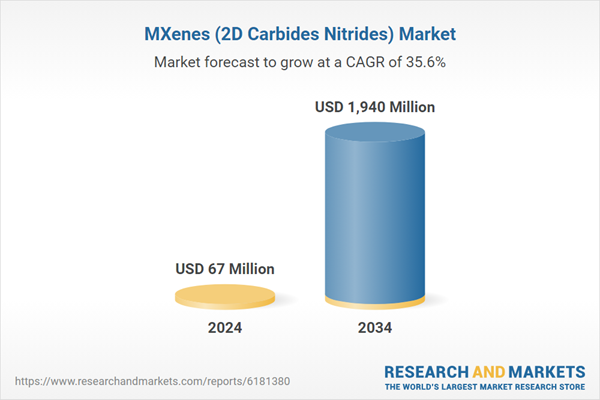Market growth is fueled by continuous advancements in nanotechnology, increased demand for next-generation materials, and growing investments across the energy storage and electronics sectors. MXenes, a group of 2D transition metal-based carbides, nitrides, and carbonitrides derived from MAX phases, are gaining traction due to their unique blend of electrical conductivity, surface hydrophilicity, mechanical flexibility, and tunable chemical properties. Their multifunctional nature allows them to serve diverse roles across advanced electronics, flexible devices, sensors, and next-gen batteries. The continued electrification of transportation systems and energy grids is increasing the need for efficient, high-performance materials. MXenes are proving to be valuable assets across the global energy value chain, particularly for high-capacity and fast-charging solutions. Additionally, their integration in telecommunication components and EMI shielding applications is growing, supported by their strong electrical performance and light weight, making them superior alternatives to traditional metals in modern electronic environments.
The growing popularity of next-generation energy storage systems, including lithium-ion, sodium-ion, and zinc-ion batteries, is a major driver for the adoption of MXenes like Ti₃C₂Tₓ. With high volumetric capacitance (~1500 F/cm³) and excellent ion transport properties, these materials are ideal for use in supercapacitors and anode technologies. As electrification expands across mobility and grid sectors, the demand for high-efficiency materials like MXenes continues to rise across the global supply chain. MXenes are also gaining traction in the electronics and communications industries due to their excellent electrical conductivity (~10,000 S/cm) and strong EMI shielding effectiveness (>60 dB in thin-film applications). These characteristics make them highly suitable for applications such as flexible electronics, sensors, RF shielding materials, and antennas. The growing need for lightweight, durable EMI shielding in compact and mobile devices is pushing MXenes into mainstream electronics design.
The single-element M-site MXenes segment generated USD 34.7 million in 2024 and is expected to reach USD 989.9 million by 2034, growing at a CAGR of 35.4%. This dominance is primarily due to the scalability and consistent high performance of Ti-based MXenes, particularly Ti₃C₂Tₓ, which remains the most extensively studied and commercially available form of MXene. Its widespread use in research and industry supports the continued expansion of this segment.
In 2024, the energy storage and conversion segment held a significant 39.8% share. The structural advantages of MXenes - metal-like conductivity, redox-active surfaces, and layered architecture with intercalation channels - make them highly effective for fast ion transport and high-surface energy storage. Materials like Nb₂C and Ti₃C₂Tₓx are being applied in systems requiring rapid charge and discharge cycles, making them ideal for grid storage and portable electronics.
China MXenes (2D Carbides Nitrides) Market accounted for USD 12.2 million in 2024 and is projected to rise to USD 360°.1 million by 2034, driven by an impressive CAGR of 35.9%. The country benefits from strong government support, control over key raw materials, and growing industrial demand for advanced 2D nanomaterials in sectors like energy, defense, and healthcare. China continues to prioritize the commercialization of nanomaterials, including carbides and nitrides, by leveraging integrated manufacturing capabilities and state-backed research initiatives.
Prominent companies operating in the Global MXenes (2D Carbides Nitrides) Market include ACS Material LLC, 6Carbon Technology (Shenzhen) Co., Ltd., Beike 2D Materials Co., Ltd., Sigma-Aldrich (Merck KGaA), and Nanjing XFNANO Materials Tech Co., Ltd. Leading companies in the MXenes (2D Carbides Nitrides) Market are focusing on high-throughput synthesis, scalability, and consistent quality control to meet increasing industrial demand. A key approach involves expanding commercial-scale production while maintaining the material's purity and structural integrity. Many firms are investing in proprietary exfoliation and surface modification technologies to tailor MXene properties for specific end uses. Collaborations with battery manufacturers and electronics developers are helping integrate MXenes into emerging technologies.
Comprehensive Market Analysis and Forecast
- Industry trends, key growth drivers, challenges, future opportunities, and regulatory landscape
- Competitive landscape with Porter’s Five Forces and PESTEL analysis
- Market size, segmentation, and regional forecasts
- In-depth company profiles, business strategies, financial insights, and SWOT analysis
This product will be delivered within 2-4 business days.
Table of Contents
Companies Mentioned
The companies profiled in this MXenes (2D Carbides Nitrides) market report include:- 6Carbon Technology (Shenzhen) Co., Ltd.
- ACS Material LLC
- Alfa Chemistry
- American Elements Corporation
- Beijing Zhongkeleiming Technology Co., Ltd.
- Beike 2D Materials Co., Ltd.
- Carbon-Ukraine LLC
- Drexel University (Technology Transfer)
- Japan Material Technologies Corporation (JMTC)
- Murata Manufacturing Co., Ltd.
- Nanjing XFNANO Materials Tech Co., Ltd.
- Nanoshel LLC
- Sigma-Aldrich (Merck KGaA)
Table Information
| Report Attribute | Details |
|---|---|
| No. of Pages | 192 |
| Published | October 2025 |
| Forecast Period | 2024 - 2034 |
| Estimated Market Value ( USD | $ 67 Million |
| Forecasted Market Value ( USD | $ 1940 Million |
| Compound Annual Growth Rate | 35.6% |
| Regions Covered | Global |
| No. of Companies Mentioned | 14 |









